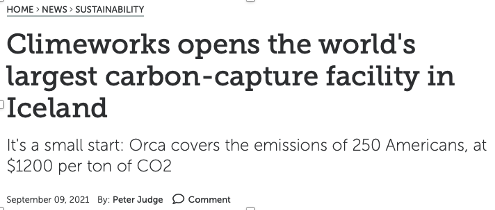Direct Air Capture (DAC) of Carbon
BEAM Natural DAC vs Chemical (Un-Natural) DAC
BEAM
Natural Carbon Dioxide Removal From the Air
(Photosynthesis)
Cost per Ton of CO2 Captured Less than 1$
Climefix, Carbon Engineering, Kemper Project
Mechanical/Chemical DA
Cost per Ton of CO2 Captured = 1200$


BEAM + Intensive Rotational Grazing
20 Tons of Carbon Added to Soil / Hectare/Year
Studies by Dr. Johnson show a 25-times increase in active soil fungal biomass and an annual average capture and storage of 10.27 metric tons soil carbon/ hectare/ year (approximately 38,000 pounds of CO2 /acre/year) Nearly doubles (74,000 metric tons of CO2 /acre/year) with ruminants.
Added BEAM Benefits
Improves germination and growth rates
Increase crop yields 50-100% or more
Improve water infiltration and retention
Better soil nutrient availability
Increases soil carbon sequestration
Decreased need for fertilizer
Reduces water usage up to 6 times

Climeworks’ direct air capture operation(Cost of CE facility = 15$ Million and can capture 4,000 tons of carbon dioxide a year) is much more expensive. On the company’s website, individuals can buy offsets that cost more than $1,200 a ton. Bulk buyers can get them cheaper. “I bought out their capacity and I got volume discount,” (Bill) Gates said in an interview last month. “I think that may be at $600 [a ton]

BEAM + Intensive Rotational Grazing
Up to 60 Tons of CO2 Removed from the Atmosphere / Hectare/Year
BEAM Benefits
Improves germination and growth rates
Increase crop yields 50-100% or more
Improve water infiltration and retention
Better soil nutrient availability
Increases soil carbon sequestration
Decreased need for fertilizer
Reduces water usage up to 6 times
BEAM (in conjunction with biochar) can have benefits in the following categories. Negative values indicate a net gain of benefit (Pays for itself in tangible financial benefits)
Forestry
Timber from both new and existing forests is an economically valuable product that could potentially store CO2 in buildings We estimate that up to 1.5GtCO2 could be utilised in 2050 in this way, at costs of between -$40 and $10 per tonne CO2.
Soil carbon sequestration
Land management techniques for soil carbon sequestration can not only store CO2 in the soil but also enhance agricultural yields. We estimate that the CO2 utilised in the form of that increased output might be as much as 0.9 to 1.9GtCO2 per year in 2050, at costs of -$90 to -$20 per tonne CO2.
Biochar
Biochar is “pyrolysed” biomass: plant material that has been burnt at high temperatures under low oxygen levels. Biochar application to agricultural soils has the potential to increase crop yields by 10% We estimate between 0.2 and 1GtCO2 could be utilised by biochar in 2050, at costs of around -$65 per tonne of CO2.

Carbon Engineering (CE) (with funding by Bill Gates) was founded more than a decade ago with the mission to develop and commercialize affordable and highly scalable carbon removal technology. A 2011 report from the American Physical Society estimated that it may cost between $600 and $1,000 per metric ton of CO2 captured from the air. Academics used to think that direct air capture would be too expensive for any practical purposes. They still tend to think that for carbon capture and storage more broadly
But even at ....(a) $100 price, removing all of humanity's annual carbon emissions would cost more than $5 trillion per year, according to Gates' book, "How to Avoid a Climate Disaster." That would require 50,000 Orca plants.

"It's probably the most expensive solution," Gates wrote.
(In addition to the DAC he advocates he is also partnering with Warren Buffet to build a nuclear reactor in Wyoming.)

The lower of two estimates for the cost of the version of DAC estimated in Chapter 2 is $600/tCO2. Table 1.1 shows the
addition to the price of primary energy (natural gas, oil, and coal) and secondary energy (gasoline, electricity from
coal, and electricity from natural gas) of imposing a surcharge of that magnitude. The cost impacts are far beyond any
contemplated for the next few decades, but they are characteristic of the costs later in the century in some economic
optimization models.11

The Kemper Project, also called the Kemper County energy facility is a natural gas-fired electrical generating station currently in Kemper County, Mississippi. Mississippi Power, a subsidiary of Southern Company, began construction of the plant in 2010. The initial, coal-fired project was central to President Obama's Climate Plan, as it was to be based on "clean coal" and was being considered for more support from the Congress in late 2016.[5] If it had become operational with coal, the Kemper Project would have been a first-of-its-kind electricity plant to employ gasification and carbon capture technologies at this scale. Kemper plant, was supposed to be in service by May 2014, at a cost of $2.4 billion. As of June 2017, the project was still not in service, and the cost had increased to $7.5 billion. According to a Sierra Club analysis, Kemper is the most expensive power plant ever built, based on its generating capacity. In June 2017, Southern Company and Mississippi Power announced that the Kemper project would switch to burning only natural gas in an effort to manage costs.
Click on the following link to see the full peer reviewed explanation of the diagram below. It shows how SCS (Soil Carbon Sequestration ie. BEAM Technology) not only does not require subsidies but pays significant economic and environmental benefits.

CO2 Capture in Perspective
The coming decade will have enormous disruptions in energy, transportation, information, food and materials. (Rethinking Humanity - a Film by RethinkX). Great focus and attention is needed to successfully address these issues and if huge sums of funds are diverted from the world's economy unnecessarily with expensive mitigation technologies promoted from the top down the peoples of the world will be not be well served.
How Climate Change Panic Costs Us Trillions, Hurts the Poor and Fails to Fix the Planet
